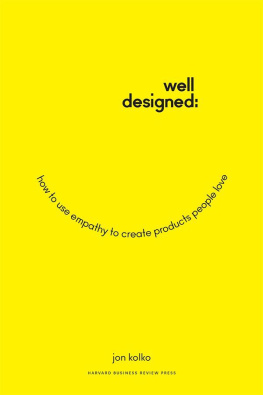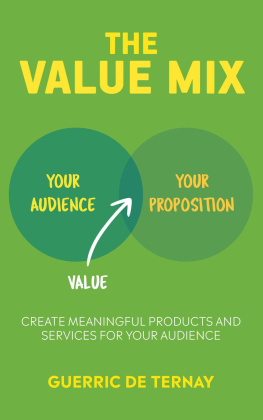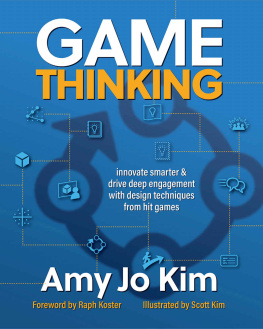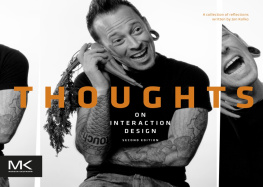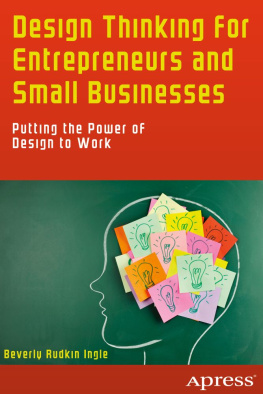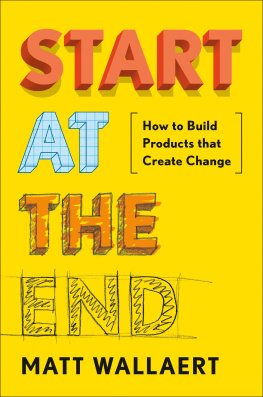well-designed
well-designed
how to use empathy to create products people love
jon kolko
HARVARD BUSINESS REVIEW PRESS
BOSTON, MASSACHUSETTS
HBR Press Quantity Sales Discounts
Harvard Business Review Press titles are available at significant quantity discounts when purchased in bulk for client gifts, sales promotions, and premiums. Special editions, including books with corporate logos, customized covers, and letters from the company or CEO printed in the front matter, as well as excerpts of existing books, can also be created in large quantities for special needs.
For details and discount information for both print and ebook formats, contact .
Copyright 2014 Jon Kolko
All rights reserved
No part of this publication may be reproduced, stored in or introduced into a retrieval system, or transmitted, in any form, or by any means (electronic, mechanical, photocopying, recording, or otherwise), without the prior permission of the publisher. Requests for permission should be directed to , or mailed to Permissions, Harvard Business School Publishing, 60 Harvard Way, Boston, Massachusetts 02163.
The web addresses referenced in this book were live and correct at the time of the books publication but may be subject to change.
Library of Congress Cataloging-in-Publication Data
Kolko, Jon.
Well-designed : how to use empathy to create products people love / Jon Kolko.
pages cm
ISBN 978-1-62527-479-3 (hardback)
1. Product design. 2. New products. 3. Consumer behavior. 4. Marketing research. I. Title.
TS171.4.K653 2014
658.5--dc23
2014032507
For Jess, my love and my best friend
contents
well-designed
introduction
from design thinking to design doing
Its hard to imagine a world without the simplicity of the iPad. But just a few short years ago, the clocks on our VCRs blinked the unset time, reminding all of us consumers of the encroaching complexity of modern technology in our homes and lives. The landscape has shifted radically and quickly, and we have changed with it. Since were living in this landscape, it may seem as though weve collectively mastered the technology game, and that we just generally understand how to produce drop-dead simple products that tame the chaos of technological advancement.
But those of us who build products and servicesthose who are behind the facade of simplicity in the murky, muddy trenches of corporations, consultancies, and start-upsare reminded of that complexity and confusion every day. Most of our product development processes are arcane and reflect outdated ways of thinking. The product requirements document, for examplea leftover artifact from the 1980sstill seems to find its way into product development meetings, and those same meetings seem to spin endlessly around arguments about features, alignment, and time-to-market. As the market demands products that are simple to understand, robust in their technical capabilities, and most importantly, delightful to engage with, our legacy processes obviously dont deliver. And with consumer expectations relentlessly rising, becoming overwhelmed with the complexity of feature matrices and specifications is easy. In this increasingly complicated and pressurized world, its hard enough delivering a useful product at all, much less one that someone really loves.
In the past decade, mostly in reaction to this anxiety and complexity, a number of methodologies have developed that purport to be fast, nimble, and quick. These methods reject documentation and deride linear process, swinging the pendulum in the direction of speed and results. Run loose and lean, it is said, in order to fail fast and succeed sooner. Yet these methods introduce a mess of their own, and as a result, consumers often end up with incomplete products that feel half-baked. While we can all take pride in shipping our products faster and more frequently, there is often real anxiety among both developers and marketers due to a lack of structure and process. Agile? More like fragile, we mutter. In cultures that have embraced many of these new methods, it can feel as though the bus is moving at tremendous speed, but no one seems to be driving.
Now consider the company Nest, one of a select crop of companies that represents a sea change in consumer product development, producing amazing new products with what appears to be ease and confidence. Nest has produced an important innovation in heating and coolingwhich might be the least exciting market segment everand its new learning thermostat has been described as sexy and beautiful; a CNET reviewer experienced startling joy using it. In the hotel industry, Airbnb is turning hospitality on its side, with a simple, beautiful service-based product that changes the way we think about travel.
New products like these have launched in sectors as varied as health care, consumer electronics, financial management, and retailand they have experienced large-scale growth and commercial success. Countless articles have described the brilliant user experience of products and services emerging from Apple, Nike, JetBlue, and Starbucks, and have correlated that experience with increases in profit.
The tiny, innovative Nest and its big and stodgy competitor Honeywell (130,000 employees) both have access to the same talent pools, to the same books and blogs, and to the same resources to help shape their products. So what was behind Googles acquisition of Nest for $3.2 billion? Why are Nests products causing consumers and reviewers to use adjectives like beautiful, drop-dead gorgeous, amazing, and revolutionary? How do companies like this make it look so easy, while the rest of us can sometimes struggle to get even the simplest set of features shipped in an elegant and effective way?
What makes these companies unique is that their products are the result of a design process, and it is this process that has led to unprecedented media fascination and consumer adoption. Modern start-ups like Airbnb and large corporations like JetBlue or Starbucks have proven that industry disruption is possible not by focusing on adding features or merely getting people to buy more, but instead by focusing on providing deep, meaningful engagement to the people who use their products or services. This engagement is achieved by designing products that seem as though they have a personality or even a soul. These products feel less like manufactured artifacts and more like good friends.
A NEW WAY OF DEVELOPING PRODUCTS
You may think of design as being about aesthetics or usability, and you may be familiar with design as it currently plays a role in your organization; typically, the role is fairly insignificant, often fuzzy, and undertaken by a few people who are deemed creative. While designers and developers may be asked to participate in brainstorming activities, their job is frequently prescribed for them: they are handed a specification and told to satisfy requirements that someone else has already defined. Ive seen talented individual contributors scratching their heads about these requirements, because they are left without a strategic view of how these choices support larger business decisions. They dont understand why product decisions were made in the first place, and they question the value of particular decisions or an entire strategic approach.
While design has common connotations of aesthetics or ease of use, an important goal of this book is to get you to think of design less as a way of making things look a certain way, and more as a way of getting things done. The design process Ill lay out in upcoming chapters leads to innovation and emotionally engaging new products and services. This process is centered around
Next page
